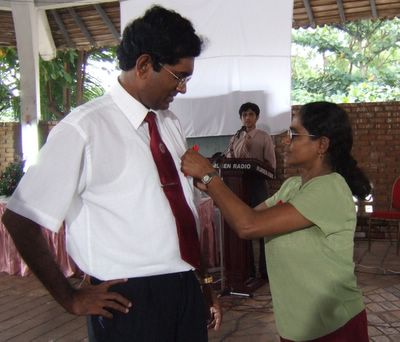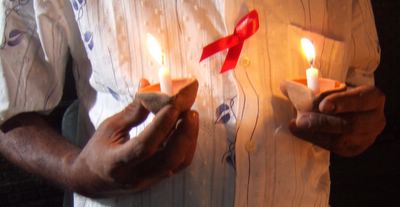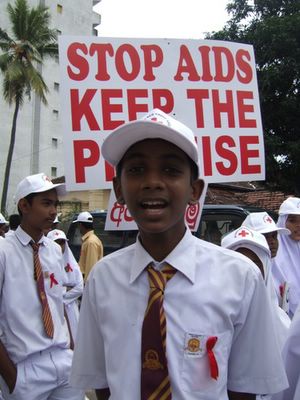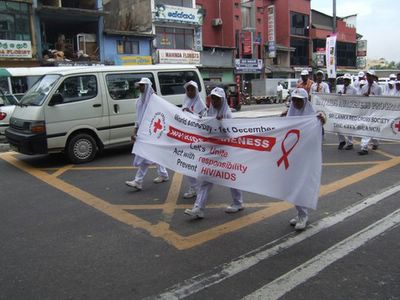“The smallest effort is not lost. Each wavelet on the ocean tost AIDS in the ebb-tide or the flow; each rain-drop makes some floweret blow; each struggle lessens human woe.” - Charles Mackay: 1814-1889, Scottish Poet, Song Writer
“In the 25 years since the first case was reported, AIDS has changed the world. It has killed 25 million people, infected 40 million more. It has become the world’s leading cause of death among both men and women aged 15- 59. It has inflicted the single greatest reversal in the history of human development. In other words, it has become the greatest challenge of our generation” says the Secretary –General of the United Nations, Kofi Annan in his World AIDS Day message.
World AIDS Day was introduced by the World Health Organization on December 01 st in 1988. This was the first time that attention around the world was focused for one day in the year on AIDS. It provided a unique opportunity to highlight the seriousness of the epidemic. Since 1988 the World AIDS Day is being observed on December 01st annually. The theme for this year’s World AIDS Days is Accountability. The theme was developed by the World AIDS Campaign support team based on their work towards the World AIDS Day, and the outcomes of the London HIV and AIDS Campaigning and Advocacy meeting in February 2005.
By now more than 65 million people have been infected with HIV according to World AIDS Campaign of UNAIDS. At this rate World Health Organization predicts that in the next 25 years another 117 million people will die, making AIDS the third leading cause of death worldwide.
UNAIDS estimates that it will take US$ 20-23 million per year by 2010 to support rapidly scaled-up AIDS response in low, and middle income countries alone. In 200 the heads of state made a promise to halt and begin to reverse the spread of AIDS by 2015.
 “Stop AIDS. Keep the Promise.’ is a tagline that will be maintained at least until the end of 2015. And for now World AIDS Day each year will have different variations of the theme whilst keeping the tagline ‘Stop AIDS. Keep the Promise.’ The World promised to stop AIDS by 2015. What will you do? The millennium Development Goal on AIDS is to halt and begin to reverse the spread of the epidemic by 2015. To achieve this, promises and commitments have been made by individuals, communities and nations.
“Stop AIDS. Keep the Promise.’ is a tagline that will be maintained at least until the end of 2015. And for now World AIDS Day each year will have different variations of the theme whilst keeping the tagline ‘Stop AIDS. Keep the Promise.’ The World promised to stop AIDS by 2015. What will you do? The millennium Development Goal on AIDS is to halt and begin to reverse the spread of the epidemic by 2015. To achieve this, promises and commitments have been made by individuals, communities and nations.
The spread of HIV is quickening with more people infected in 2006 than in any previous year. Everyday 8,000 people die of AIDS-related diseases.15-24 year-olds accounted for 40% of the 4.3 million new infections this year, and two thirds of these are young women.
According to the latest figures published on November 21st 2006, by UNAIDS/WHO AIDS Epidemic Update, an estimated 39.5 million people are living with HIV. There were 4.3 million new infections in 2006 with 2.8 million (65%) of these occurring in sub-Saharan Africa and important increases in Eastern Europe, and Central Asia, where there are some indications that infection rates have risen by 50% since 2004. In 2006, 2.9 million people died of AIDS-related illnesses.
An estimated 8.6 million (6.0 million-13.0 million) people were living with HIV in Asia in 2006, including 960,000 (640,000- 2.5 million) who became newly infected in the past year. Approximately 630,000 (430,000- 900,000) died from AIDS-related illnesses in 2006. The number of people receiving antiretroviral therapy has increased more than threefold since 2003, and reached an estimated 235,000 (180,000- 290,000) by June 2006. This represents about 16% of the total number of people in need of antiretroviral treatment in Asia, according to the UNAIDS/WHO AIDS Epidemic Update December 2006.Only Thailand has succeeded in providing treatment to at least to 50% of people needing it according to UNAIDS/WHO 2006.
“Though the world has made progress in expanding HIV/Aids treatment to adults, children have been left behind. Only one in 10 children who needs treatment is getting it,” Bill Clinton former US President and the head of the Clinton Foundation said in his speech at the Delhi hospital. He was in India recently to launch the federal government’s national programme to treat children with HIV The Clinton Foundation was et up in 2002 to provide technical and financial help to poorer countries struggling to stop the spread of HIV/AIDS around the world. Since its inception, The Clinton Foundation HIV/AIDS Initiative (CHAI) has helped bring AIDS care and treatment to over 415,000 people living with HIV/AIDS in the world. The Clinton Foundation HIV/AIDS Initiative (CHAI) has negotiated with pharmaceutical companies to make HIV/AIDS treatment cheaper for children in developing countries.
UNAIDS Scaling up towards universal access: Progress in Asia and the Pacific, October 2006 states that UNAIDS is working with the government and civil society to revisit the targets already set and to make them ambitious and realistic. The process of target setting is ongoing and is expected to be completed by the end of 2006 in most countries . Bangladesh, Indonesia, China, Laos, Vietnam, Myanmar, and Sri Lanka are categorized as countries which are slow but moving.
Keeping the Promise? Sri Lanka
In Sri Lanka so far 815 HIV positives have been reported up to September 2006. 151 deaths have been reported up to now. 26 children have been reported to have infected with HIV. They all got infected through their mothers. HIV surveillance is conducted annually by the National STD/AIDS Control Programme (NSACP). However the Joint United Nations Programme on HIV/AIDS (UNAIDS) estimates the actual number of People Living With HIV/AIDS (PLWHA) to be 5,000 (3,000-8,300), and classifies Sri Lanka as a low-prevalence country with an adult prevalence rate of less than 0.1 percent.
95% of HIV transmission is through unprotected sex. 3% of HIV is transmitted through mother to child, 1% through blood transfusion, and 1% through by drug users injecting drugs, the rest of the drug users inhales drugs. Although no formal studies have been carried out, Sri Lanka has an estimated 30,000 drug users according to Panos Global AIDS Programme in July 2006.
Anti Retro Viral Treatment (ARV) began in latter part of 2004. World Bank strengthened the national response. From December 1 st 2004, 82 beneficiaries started to receive free Anti Retro Viral Treatment (ARV). 213 people have developed AIDS.
According to Panos Global AIDS Programme in July 2006, the World Bank is the major donor to the National HIV/AIDS Prevention Programme (NHAPP) in Sri Lanka and a grant of US$ 12.5 million (Sri Lankan Rupees 1,250 million) was made available for HIV/AIDS activities for the period 2003-2008. Of this sum, US$ 11.5 million (Sri Lankan Rupees 1,150 million) was allocated for prevention activities, and US$ 1 million (Sri Lankan Rupees 100 million) for treatment. Although the World Bank project was approved in 2003, funds were released only in 2005. According to the National Strategic Plan for Prevention and Control of HIV/AIDS (the Strategic Plan), a budget of US$ 11,588,000 was needed for HIV/AIDS by the Ministry Of Health (MOH) for the 2002-2006 period. Of this the government was to contribute US$ 3.6 million (Sri Lankan Rupees 360 million), the private sector US $ 620,000 (Sri Lankan Rupees 62 million), and Non- Governmental Organizations US$ 145,000 (Sri Lankan Rupees 14.5 million). The Ministry Of Health is currently preparing the next Strategic Plan for the period 2007-2011. The Strategic Plan consists of three technical units for prevention, care and surveillance.
There are currently 26 STD clinics (Sexually Transmitted Diseases) in the Island. There is no consultant venerologists at the Jaffna Teaching Hospital, and the STD clinic lack adequate testing facilities, and no privacy for the persons. The accumulated number of People Living With HIV/AIDS (PLWHA’s) is 38, while people living with HIV is 16 to date. There are more women than men living with HIV/AIDS. Out of these, two are children. The first case of HIV positive was detected in 1993 in Jaffna.
“HIV/AIDS is like landmines. We have to be very careful. Sri Lanka is a low-prevalence country compare to African countries, where the prevalence rate is 30%-40%. When the prevalence rate is low, people do not make a note of it until it becomes a threat. There is no compulsory testing for HIV/AIDS in Sri Lanka. It’s voluntary testing, except for the people who go abroad for employments are tested for HIV/AIDS. The treatment is free of charge in Sri Lanka. It’s an incentive. More work to be done to create awareness on HIV/AIDS” said the Minister for Health at a press conference in Colombo recently.
World leaders still failing to deliver on funding for HIV/AIDS says ActionAid
“Rich countries are in a danger of making mockery for their own commitment to fight this” said Aditi Sharma Head of the HIV/AIDS team at ActionAid in a press release to mark the World AIDS Day.
She further states that , “We cannot allow leaders to abandon the fight against AIDS as if it were some passing fashion. More than a year after world leaders committed to access there is still no funding plan to finance this goal.
We must not allow prejudice and ignorance to diminish HIV/AIDS prevention efforts. Governments must allocate significant funds to back rhetoric on promoting women’s rights and the cost of treatment must be cut. And preventative healthcare needs to be accessible to halt the needless death of millions of people. While there is now some recognition that the fight against AIDS will not be won unless gender inequity and violence against women and girls are targeted., there is no government or donor around the world committing adequate funds or implementing programmes needed to advance the sexual and reproductive rights of women, and reduce their vulnerability.”
The funding gap is still US$ 10 million a year and only billion a year and only 20% of people living with the virus are receiving treatment. Across Asia, one in six people are receiving treatment while in India treatment remains at below 10% of need. But worldwide, only 20% of all young women understand how to prevent transmission.
Africa continues to bear the brunt of the epidemic with 72% of global deaths caused by the virus, according to UNAIDS Report on the global AIDS epidemic 2006.
Red Ribbon
According to the UNAIDS website, the Red Ribbon symbolizes the AIDS awareness. In 1988 a group called Visual AIDS was founded by arts professionals as a response to the effects of AIDS on the arts community and as a way of organizing artists, arts institution, and arts audiences towards direct action on AIDS.
Three years later, in 1991, some of the Visual AIDS artists came together to design a visual symbol to demonstrate compassion for people living with HIV and their care givers. Inspired by the yellow ribbons honoring American soldiers serving in the Gulf war, the artists chose to create a red ribbon to symbolize support and solidarity for people living with HIV and to remember those who have died from AIDS-related illnesses. The colour red was chosen for its, “connection to blood and the idea of passion — not only anger, but love, like a valentine,” the Project founders say. The project was to become known as the Red Ribbon Project.
The symbol came to Europe on a mass scale on Easter Monday in 1992, when more than 100,000 red ribbons were distributed during the Freddie Mercury AIDS Awareness Tribute Concert at Wembley stadium. More than one billion people in more than 70 countries worldwide watched the show on television. Throughout the nineties many celebrities wore red ribbons, encouraged by Princess Diana’s high profile support for AIDS.
By mobilizing the visual arts communities , Visual AIDS raises money to provide direct services to artists living with HIV/AIDS.
Today the Red Ribbon has become an international symbol of solidarity and support for people living with HIV. Wearing a red ribbon is a simple and powerful way to challenge the stigma and prejudice surrounding AIDS .Wear yours with pride this World AIDS Day. Wear a Red Ribbon and show that, you care for them.















 “Stop AIDS. Keep the Promise.’ is a tagline that will be maintained at least until the end of 2015. And for now World AIDS Day each year will have different variations of the theme whilst keeping the tagline ‘Stop AIDS. Keep the Promise.’ The World promised to stop AIDS by 2015. What will you do? The millennium Development Goal on AIDS is to halt and begin to reverse the spread of the epidemic by 2015. To achieve this, promises and commitments have been made by individuals, communities and nations.
“Stop AIDS. Keep the Promise.’ is a tagline that will be maintained at least until the end of 2015. And for now World AIDS Day each year will have different variations of the theme whilst keeping the tagline ‘Stop AIDS. Keep the Promise.’ The World promised to stop AIDS by 2015. What will you do? The millennium Development Goal on AIDS is to halt and begin to reverse the spread of the epidemic by 2015. To achieve this, promises and commitments have been made by individuals, communities and nations. A National award was conferred on Late Dr. Kamalika Abeyartne by the former President Mrs. Chandrika Bandaranaike Kumaratunga in 2005.Dr.Kamalika Abeyratne was honoured by the then President Mrs. Chandrika Bandaranaike Kumaratunga for the medical service, she rendered to the society on the International Women’s Day in 2000.She was hounoured with an award by AIDS Coalition for Care, Education, and Support Services (ACCESS) in 1999, for her dedicated service to create awareness about HIV/AIDS in Sri Lanka. And Zonta Club recognized her with an award in 2000.
A National award was conferred on Late Dr. Kamalika Abeyartne by the former President Mrs. Chandrika Bandaranaike Kumaratunga in 2005.Dr.Kamalika Abeyratne was honoured by the then President Mrs. Chandrika Bandaranaike Kumaratunga for the medical service, she rendered to the society on the International Women’s Day in 2000.She was hounoured with an award by AIDS Coalition for Care, Education, and Support Services (ACCESS) in 1999, for her dedicated service to create awareness about HIV/AIDS in Sri Lanka. And Zonta Club recognized her with an award in 2000.

